Do you love spending time in their garage workshop, tinkering with tools, and creating incredible projects? If so, you know the importance of creating a safe and well-ventilated workspace. A proper workshop layout ensures your safety and is crucial in optimizing airflow.
Regarding workshop safety, having the right equipment and layout is critical. From proper ventilation systems to safety gear, there are various factors to consider when setting up your workspace. By implementing an optimal workshop layout, you can enhance the safety of your environment and promote better airflow throughout the space.
One of the primary concerns in a garage workshop is ventilation. The air can become stagnant and filled with fumes, dust, and other potentially harmful particles without proper airflow. This can lead to health issues and decreased productivity. Investing in a ventilation system that effectively removes harmful air pollutants is essential for maintaining a healthy workshop environment.
In addition to proper ventilation, having the right safety equipment is vital to ensure a safe workshop. Safety gear such as protective eyewear, gloves, masks, and earplugs should be easily accessible and used whenever necessary. Organizing your seminar in a way that allows for quick and easy access to safety equipment can significantly reduce the risk of accidents.
Furthermore, an optimal workshop layout promotes efficient workflow, making navigating your workspace and accessing tools and materials more accessible. A cluttered and disorganized workshop can lead to accidents and wasted time searching for tools. By arranging your tools and workstations in an organized manner, you can maximize productivity and reduce the risk of injuries.
In conclusion, creating an optimal workshop layout is crucial for safety and airflow. By prioritizing proper ventilation, investing in the right safety equipment, and organizing your workspace efficiently, you can ensure a safe and healthy environment for all your workshop endeavors.
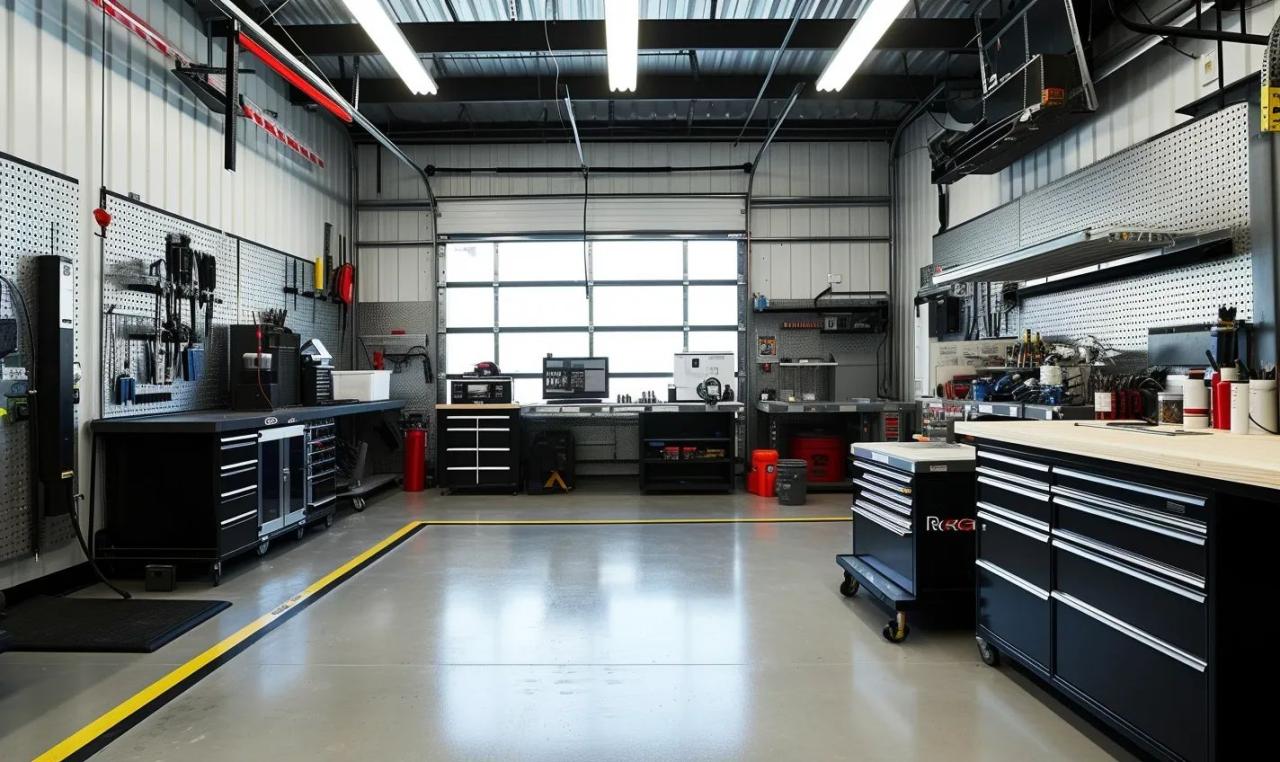
The Importance of Workshop Layout for Safety and Airflow
The layout is crucial when creating a safe and productive garage workshop. Not only does it impact your efficiency and workflow, but it also directly affects your safety and overall wellbeing. By designing a workshop layout that prioritizes safety and optimal airflow, you can create a space that enhances your productivity and protects your health.
Why is workshop layout important for safety?
An organized workshop layout is essential for several reasons:
- Minimizing hazards: A well-planned workshop layout can help minimize potential hazards by ensuring clear pathways, preventing tool collisions, and providing designated areas for different activities.
- Easy access to safety equipment: Proper placement of safety equipment, such as fire extinguishers, first aid kits, and eye wash stations, ensures quick and easy access during emergencies.
- Efficient ergonomics: A thoughtfully designed layout considers ergonomics, reducing the risk of repetitive strain injuries and improving overall comfort.
- Preventing accidents: By keeping machinery, tools, and hazardous substances adequately stored and organized, you can minimize the risk of accidental injuries.
How does the workshop layout impact airflow?
Adequate airflow is crucial in a garage workshop to maintain a healthy working environment:
- Removal of fumes and toxins: Proper ventilation systems, such as exhaust fans or air purifiers, help remove fumes, dust, and toxins generated from various operations, ensuring clean air circulation.
- Temperature control: Effective airflow helps regulate temperature, preventing heat buildup and ensuring a comfortable working environment.
- Preventing condensation: Good airflow helps reduce condensation, preventing the accumulation of moisture that can lead to rust and damage to tools and equipment.
By optimizing the workshop layout for airflow, you can enhance the effectiveness of ventilation systems and ensure a healthy and safe atmosphere.
Whether setting up a new workshop or reorganizing an existing one, keeping safety and airflow in mind is crucial. You can create a workshop layout that promotes optimal safety and airflow by considering factors like efficient workflow, clear pathways, proper equipment placement, and ventilation systems.
Remember, your workshop should be where you can work confidently, knowing that your surroundings support your productivity and prioritize your wellbeing-. So, invest time and effort into designing a workshop layout that is safe and conducive to a comfortable and efficient working environment.
Critical Considerations for Setting Up a Safe and Well-Ventilated Workshop
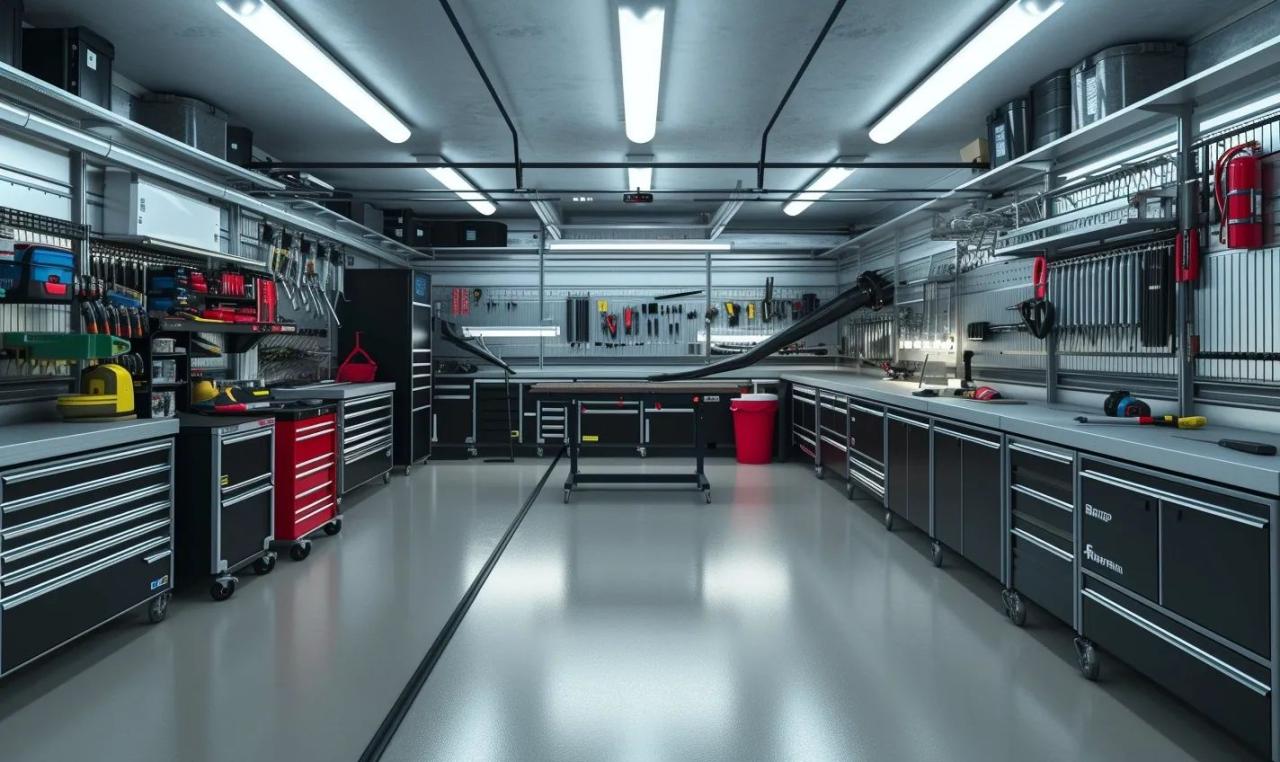
Safety and airflow should be your top priorities for a garage workshop. A well-designed workshop layout can significantly reduce the risk of accidents and create a comfortable working environment. Here are some key considerations to keep in mind:
Clear and Organized Workspace
Start by decluttering your workshop space and ensuring everything has its designated place. Keep walkways clear and create specific storage areas for tools and equipment. Maintaining a tidy and organized workspace minimizes the risk of tripping over objects and improves overall safety.
Adequate Ventilation System
Proper ventilation is essential for removing harmful fumes, dust, and airborne particles from your workshop. Install an effective ventilation system such as an exhaust fan or a dedicated air filtration unit to maintain good air quality. This helps protect your health and prevents potential respiratory issues.
Natural Lighting and Emergency Lighting
Maximize natural lighting in your workshop by positioning workstations near windows or installing skylights. Not only does this improve visibility, but it also creates a more pleasant working atmosphere. Additionally, ensure you have emergency lighting in place in case of power outages or other unforeseen circumstances.
Safety Equipment
Invest in appropriate safety equipment to protect yourself from potential hazards. This includes safety glasses, ear protection, gloves, and a sturdy work apron. By wearing the right gear, you minimize the risk of injury and work more confidently in your workshop.
Fire Safety Measures
Implement fire safety measures to prevent accidents and minimize damage in case of a fire. Have fire extinguishers readily available in easily accessible locations and install smoke detectors and fire alarms. Regularly inspect and maintain these equipment to ensure they are in good working condition.
Ergonomics
Consider the ergonomics of your workshop layout to minimize strain and fatigue—position workbenches and tools comfortably to avoid strain on your back or joints. Incorporate anti-fatigue mats to reduce the stress on your feet during long hours of standing.
Considering these fundamental considerations, you can create a safe and well-ventilated workshop that promotes productivity and peace of mind. Remember, a well-designed workshop enhances safety and creates a more enjoyable and efficient work environment.
Designing an Efficient Layout to Minimize Hazards in Your Garage Workshop
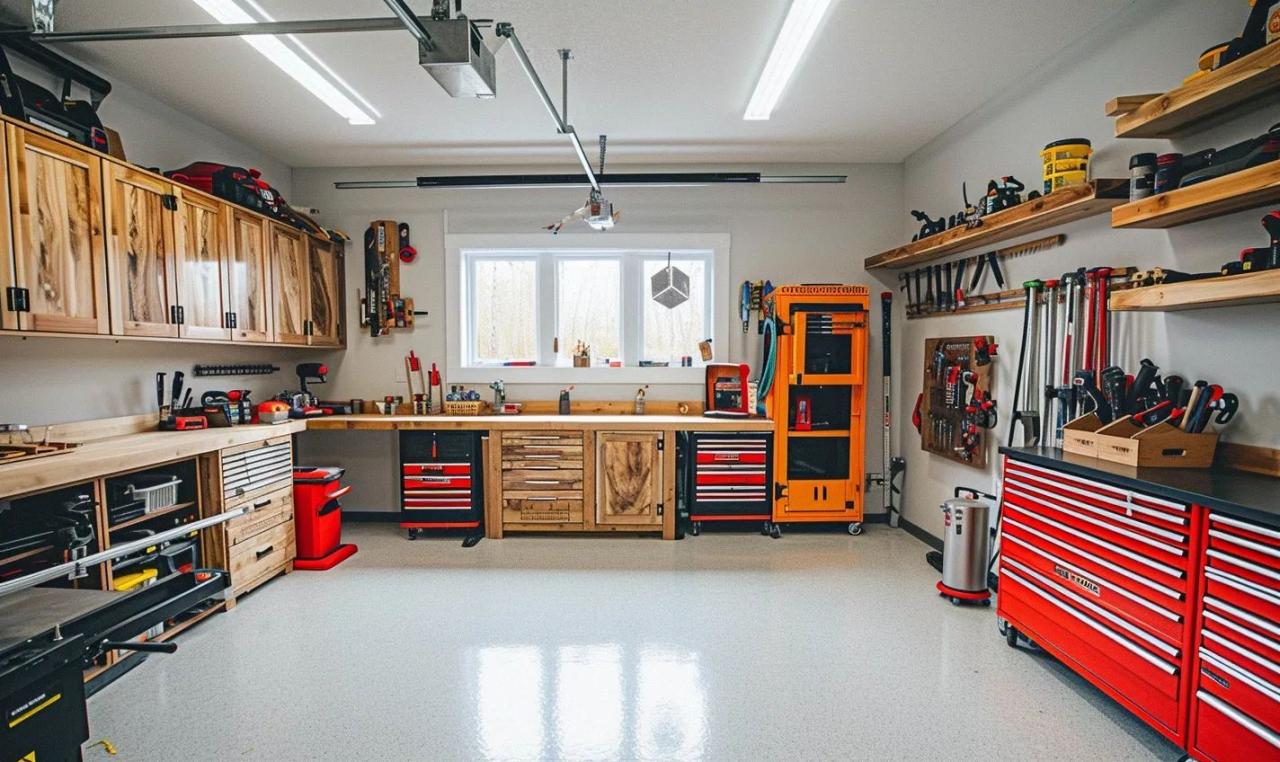
Designing an efficient layout is crucial for safety and airflow when setting up a garage workshop. A well-planned layout reduces hazards and ensures a comfortable and productive working environment. Here are some key factors to consider when designing your workshop layout:
Clear Pathways
Start by creating clear pathways throughout your workshop. These pathways should be wide enough for easy movement and not obstructed by tools, equipment, or clutter. Keeping your pathways clear minimizes the risk of tripping or falling while navigating your workspace.
Workstation Placement
Strategically place your workstations to optimize workflow and safety. Consider the frequency of use for each workstation and arrange them accordingly. Place frequently used tools and equipment within easy reach, minimizing the need for excessive movement and reducing the risk of accidents.
Additionally, keep in mind the layout of your power outlets. Ensuring that power cords are appropriately managed and not creating trip hazards is essential for maintaining a safe working environment.
Proper Ventilation
Workshop ventilation is vital for maintaining good air quality and preventing the buildup of hazardous fumes or dust particles. The location of your ventilation system should be well-planned to remove harmful airborne contaminants effectively.
Consider installing exhaust fans near potential sources of pollutants, such as sanding stations or painting areas. This will help safeguard your health by efficiently venting harmful chemicals and particles, ensuring a safer working environment.
Organized Storage
Proper storage is critical to reducing clutter and hazards in your workshop. Utilize shelves, pegboards, and tool racks to keep your tools and equipment organized and easily accessible. Having designated storage spaces minimizes the risk of loose items causing accidents and makes maintaining a clean and tidy workspace easier.
Add labels or color-coding systems to identify the location of specific tools and materials. This saves time searching for items and enhances safety by minimizing the chance of mishandling or using the wrong tools.
Adequate Lighting
Good lighting is essential for a safe and efficient workshop. Ensure your workspace is well-lit by installing overhead or task lighting at individual workstations. Natural light can also be utilized by incorporating windows or skylights into your workshop design.
Proper lighting helps prevent accidents by improving visibility, enhancing accuracy, and reducing eye strain, allowing you to work comfortably and effectively.
You can create a safer and more productive workspace by considering these critical factors in your workshop layout. Safety should always be a top priority when designing your garage workshop.
Ensuring Proper Ventilation to Protect Your Health in the Workshop
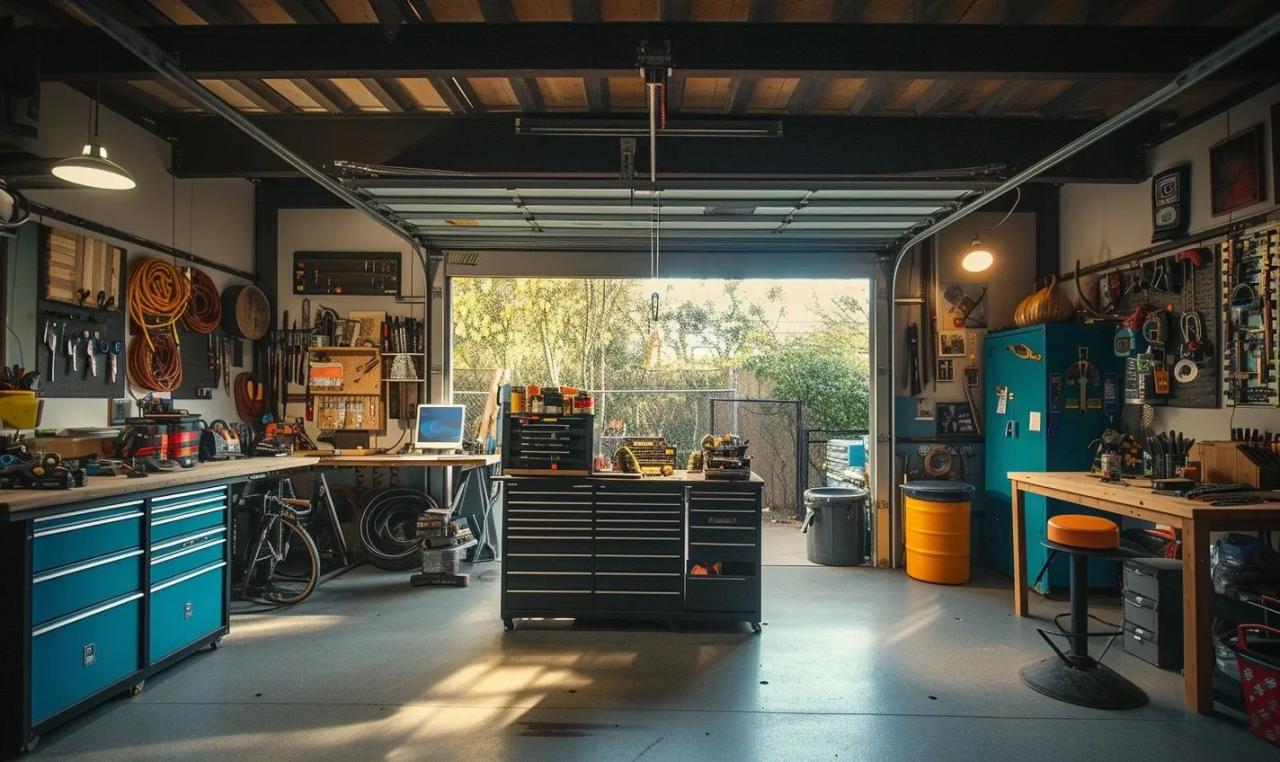
Ensuring proper ventilation is crucial for your health and overall workspace quality when setting up a safe and well-ventilated workshop. Harmful fumes, dust, and other pollutants can accumulate without adequate airflow, posing significant risks to your respiratory system and overall well-being-. Here are a few essential tips and considerations to keep in mind when it comes to workshop ventilation:
Invest in a Quality Ventilation System
Investing in a high-quality ventilation system is the first step in ensuring proper ventilation. This system will help remove potentially harmful contaminants from the air, maintaining a clean and safe environment for you to work in. Consider installing exhaust fans, air filters, or even a complete HVAC system, depending on the size of your workshop and the projects you undertake.
Position Your Equipment Strategically
Correctly positioning your equipment can also enhance airflow in your workshop. Ensure that your workbenches and tools are not blocking air vents or obstructing the airflow path. This allows air to circulate freely, reducing any stagnant or polluted air pockets that may develop.
Create Adequate Intake and Exhaust Points
It’s essential to have a balanced intake and exhaust system in your workshop to maintain optimal airflow. By creating adequate intake points, such as windows or vents, fresh air can enter the space, diluting any potentially harmful contaminants. Similarly, exhaust points, such as fans or ducts, will help expel polluted air and maintain a healthier working environment.
Keep the Workspace Clean and Organized
A clutter-free workshop is visually appealing and improves airflow and safety. Regularly clean your workshop, removing any dust, debris, or unused materials that may obstruct ventilation pathways. Additionally, proper organization ensures that equipment and tools are stored in designated areas, preventing them from impeding adequate airflow.
Use Personal Protective Equipment
While proper ventilation is essential, protecting yourself individually is equally vital. Wear appropriate personal protective equipment (PPE) such as respirators, goggles, gloves, and ear protection to safeguard against potential hazards. PPE helps filter out contaminants and protects you from injuries and other risks associated with workshop activities.
By considering these tips and implementing the necessary measures to improve ventilation in your workshop, you can create a much safer and healthier workspace. Remember, proper ventilation protects your health and enhances your overall productivity and enjoyment as you work on your projects.
Essential Safety Equipment for a Well-Organized Workshop Layout
Proper safety equipment is paramount when creating a safe and efficient workshop layout. These essential tools and gear protect you from potential hazards and ensure your workspace is well-organized and optimized for maximum safety and productivity. Here are five must-have safety equipment for your workshop layout:
Personal Protective Equipment (PPE)
Wearing proper personal protective equipment is crucial in any workshop environment. This includes safety goggles, ear protection, gloves, and dust masks. These protective gears shield you from flying debris, harmful fumes, loud noises, and potential injuries. Ensure the proper PPE is readily available, and insist on enforcing its use within your workshop.
Fire Safety Equipment
No workshop is complete without adequate fire safety equipment. Install fire extinguishers in easily accessible locations and ensure your workshop has proper fire exits. Also, having a fire blanket and first-aid kit can be invaluable in emergencies. Regularly inspect and maintain these safety measures to guarantee their functionality.
Safety Guards and Machine Shields
Implementing safety guards and machine shields is essential if your workshop uses power tools or heavy machinery. These protective barriers help prevent accidents by keeping operators safe from moving parts. Ensure that all machines are equipped with guards that meet safety standards, and make it a priority to train your staff on their proper use.
Spill Control and Cleanup Kits
Workshop spills are not only messy but can also pose serious safety risks. Investing in spill control and cleanup kits can help you promptly manage and contain any spills, reducing the chance of slips and falls. These kits typically include absorbent materials, brooms, dustpans, and disposable bags. Placing them strategically throughout your workshop allows for quick access when emergencies occur.
A Well-Stocked First-Aid Station
Accidents can happen anywhere, and having a well-stocked first-aid station is crucial for providing immediate medical care. Your first-aid kit should contain essential items such as bandages, antiseptics, pain relievers, and eyewash solutions. Ensure that it is easily accessible and that all employees know its location.
Incorporating these essential safety equipment into your workshop layout creates a secure and well-organized environment. Prioritize the wellbeing of yourself and your staff by investing in the necessary safety tools and gear. Remember, a safe workshop is a productive workshop!
How to Optimize Airflow in Your Garage Workshop for a Comfortable Working Environment
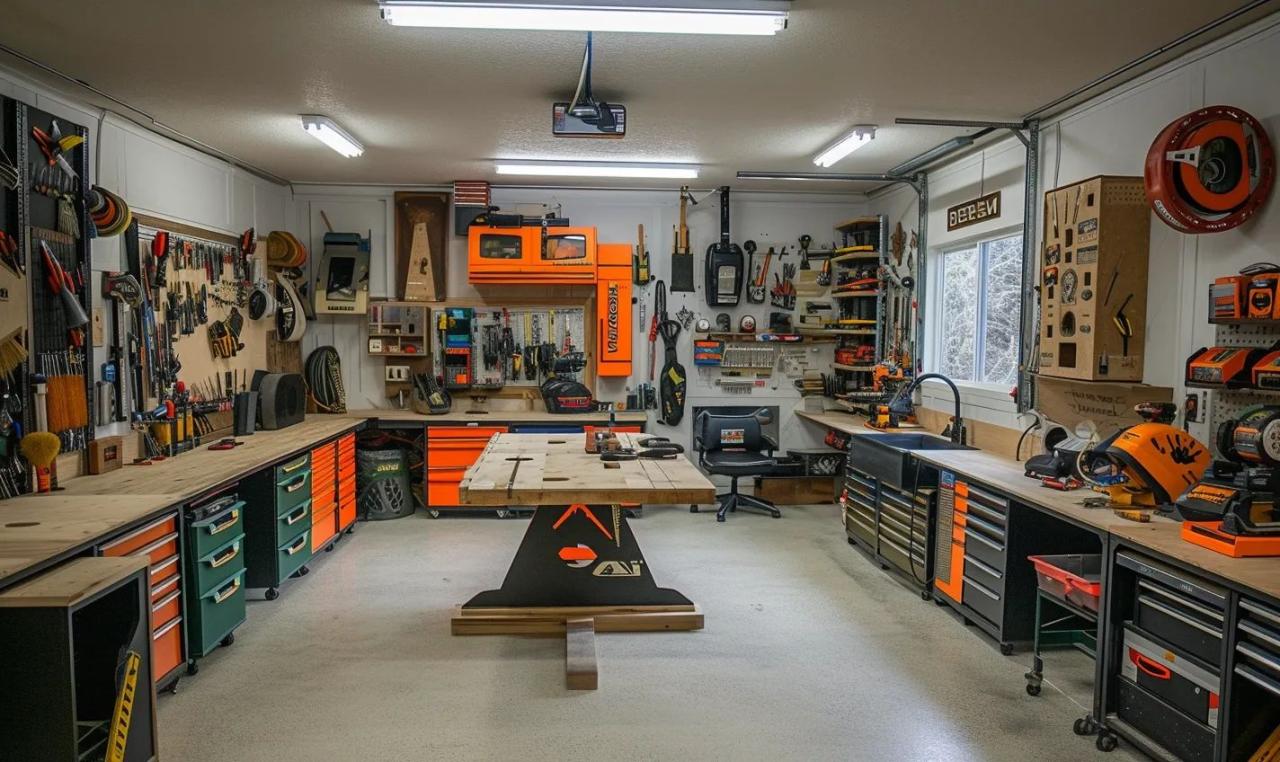
Optimizing airflow is vital for creating a comfortable and safe working environment in your garage workshop. Proper ventilation enhances air quality, helps regulate temperature, reduces the risk of respiratory issues, and prevents the buildup of harmful fumes or gases. Follow these tips to ensure optimal airflow in your workshop:
Assess Your Existing Ventilation
Start by evaluating your current ventilation setup. Check if you have windows, doors, or exhaust fans that can facilitate adequate airflow. Identify any obstructions hindering air movement, such as clutter or misplaced equipment.
Utilize Natural Ventilation
Take advantage of natural airflow by strategically placing windows or installing vents in your garage workshop. Consider cross-ventilation techniques, where you position windows or vents on opposite sides of the space, allowing air to circulate effectively.
Install Exhaust Fans
Exhaust fans are an excellent addition to any garage workshop, as they help expel stagnant or polluted air. Install them near workstations, particularly when you use volatile chemicals, paints, or other substances that produce strong odors or fumes.
Use Portable Fans
Incorporate portable fans to enhance airflow within your workshop further. Place them strategically, directing the breeze towards work areas or areas prone to heat buildup. Adjustable fans allow you to control the airflow based on your specific needs.
Maintain a Clean and Organized Workspace
Clutter can impede the airflow in your workshop, leading to stagnant or poorly circulated spaces. Keep your workspace clean and well-organized, storing tools, materials, and equipment properly. This not only helps with airflow but also minimizes safety hazards.
Consider Air Filtration Systems
If you frequently work with fine dust particles, consider investing in air filtration systems or air purifiers to remove harmful contaminants from the air. These systems can help reduce the risk of respiratory issues and maintain a healthy working environment.
Regular Maintenance and Cleaning
Ensure you regularly inspect and clean your ventilation systems, including fans, filters, and exhaust ducts. Replace filters as recommended by the manufacturer to keep the airflow efficient and prevent the accumulation of dust or debris that may hinder performance.
By optimizing airflow in your garage workshop, you can create a more comfortable working environment that promotes your health and safety. Implement these tips to enhance air quality and minimize the risk of respiratory issues, ensuring that you can focus on your projects with peace of mind.
The Role of Ventilation Systems in Ensuring Workshop Safety
Proper ventilation is crucial when creating a safe and comfortable working environment in your garage workshop. Adequate airflow not only helps to maintain a comfortable temperature but also ensures the removal of potentially harmful fumes, dust, and airborne particles. This article will explore the importance of ventilation systems in workshop safety and the options available for optimal airflow.
Why is ventilation important?
Ventilation is essential for several reasons:
- Health and Safety: Without proper ventilation, hazardous chemicals, fumes, and dust can accumulate in the workshop, putting your health at risk. Ventilation systems help to remove these pollutants and provide clean air to breathe.
- Comfort and Productivity: Good airflow helps to regulate the temperature and humidity levels, creating a comfortable working environment. This can enhance your productivity and prevent fatigue.
- Fire Hazard Prevention: Adequate ventilation helps to reduce the accumulation of flammable vapors, minimizing the risk of fire hazards.
Options for workshop ventilation systems
Here are some standard ventilation systems that you can consider for your garage workshop:
- Natural Ventilation: Utilizing windows, doors, or vents to facilitate the entry and exit of air is an economical option. However, it may not provide sufficient airflow control.
- Mechanical Exhaust Fans: These fans can be installed strategically to actively remove stale air and bring fresh air from the outside.
- Ducted Ventilation Systems: These systems use a network of ducts and fans to create an airflow pattern that effectively removes pollutants.
Tips for adequate workshop ventilation
Here are a few tips to ensure optimal airflow in your garage workshop:
- Use Local Exhaust Ventilation: Install ventilation hoods or extractors near workstations where hazardous substances are used to capture fumes at the source.
- Strategic Placement: Position your mechanical exhaust fans or ventilation openings in areas where they can effectively remove contaminants.
- Regular Maintenance: Keep your ventilation system clean and well-maintained to ensure proper functioning.
Investing in a reliable ventilation system is essential in ensuring the safety and wellbeing of you and your workshop. Ventilation systems contribute significantly to a productive and enjoyable workshop experience by removing hazardous substances and maintaining a comfortable working environment.
Assessing and Improving the Flow of Air in Your Workshop for Enhanced Safety
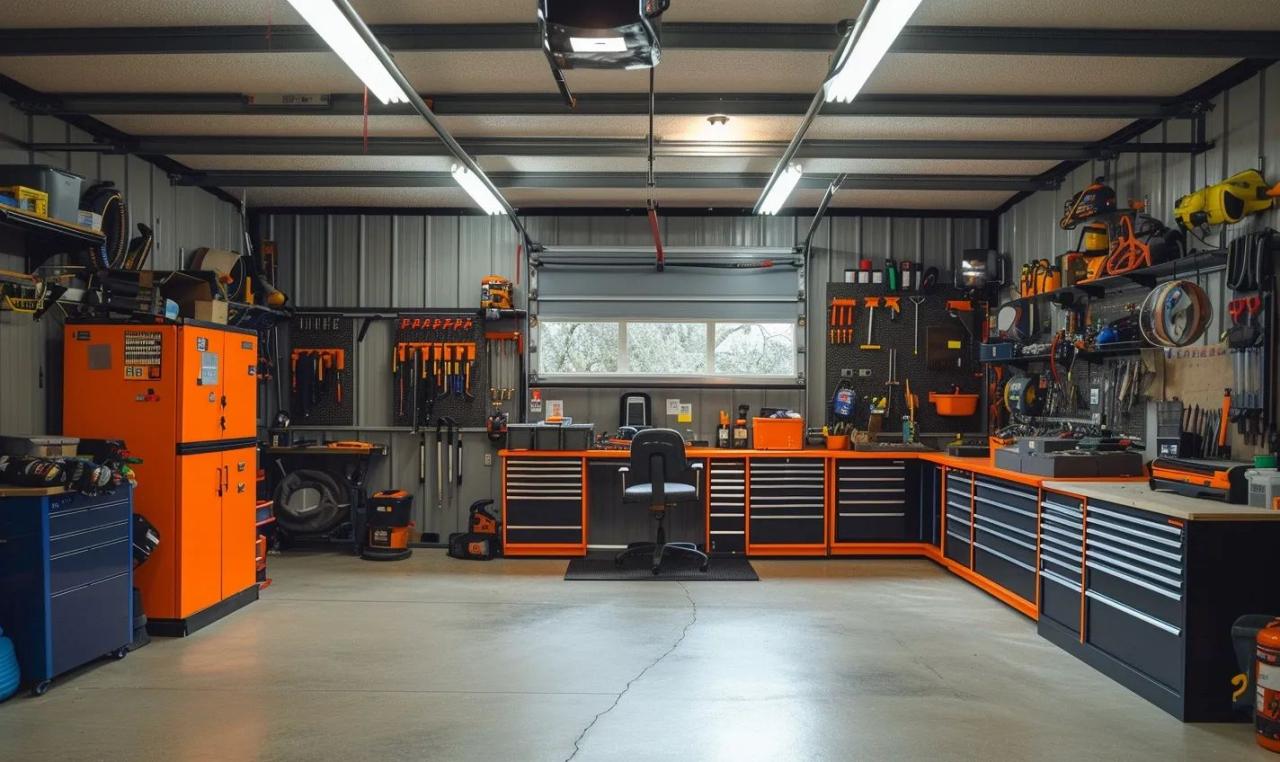
Proper airflow is paramount in ensuring a safe and comfortable working environment in your garage workshop. Good ventilation helps remove harmful fumes and airborne particles but also helps regulate temperature and humidity levels. In this article, we will discuss some critical tips for assessing and improving the airflow in your workshop to enhance safety and maintain a healthy workspace.
Evaluate the Existing Ventilation System
Begin by assessing the effectiveness of your current ventilation system. Consider factors such as the workshop size, the number of operating machines, and the type of work being performed. Check for any blockages or restrictions in air passages, and ensure exhaust fans or air purifiers function optimally.
Increase Natural Ventilation
Natural ventilation can be a cost-effective way to improve airflow in your workshop. Maximize the use of windows and doors to allow cross ventilation, which enables fresh air to enter from one side and exhaust air to exit from the other. Consider installing adjustable louvers or vents to control the airflow and prevent drafts.
Utilize Mechanical Ventilation Systems
If natural ventilation alone is insufficient, mechanical systems can provide a boost. Install exhaust fans strategically to draw out contaminated air and introduce fresh air. Consider using high-velocity fans for better air circulation. Ensure the ventilation system is appropriately sized and positioned to achieve optimal airflow.
Properly Position Workstations and Machines
The layout and positioning of workstations and machines can significantly impact airflow in your workshop. Arrange equipment in a way that allows for efficient movement of air. Avoid cluttering the workspace, as it can obstruct airflow and lead to stagnant zones where harmful particles accumulate. Keep in mind the direction of airflow and position machines accordingly.
Regular Maintenance and Cleanliness
Maintaining a clean and well-organized workshop is crucial for optimal airflow. Regularly clean dust and debris from surfaces, machinery, and air filters. Ensure that exhaust ducts and vents are not blocked or clogged. Consider using air filters or purifiers to trap airborne particles and maintain a healthy working environment.
By assessing and improving the airflow in your workshop, you can enhance safety, protect your health, and create a comfortable working environment. Remember, a well-ventilated seminar not only promotes better air quality but also contributes to increased productivity and overall wellbeing.
Best Practices for Arranging Tools and Equipment for Efficient Workflow and Safety
Now that we’ve covered the importance of workshop layouts for optimal safety and airflow, it’s time to focus on arranging your tools and equipment for efficient workflow and enhanced safety. By following these best practices; you can create a well-organized and productive workspace that minimizes hazards and improves your overall experience in the garage.
Group Similar Tools and Equipment Together
Start by organizing your tools and equipment into groups based on their purpose or function. This will make it easier to locate what you need and avoid wasting time searching for tools in different areas of your workshop.
Utilize Ergonomic Storage Solutions
Invest in storage options that are designed with ergonomics in mind. This includes tool chests with easy-access drawers, wall-mounted racks, and pegboards. Keeping your tools within reach and properly organized can reduce the risk of accidents and maximize your efficiency.
Keep Frequently Used Tools Easily Accessible
Identify the tools and equipment you use most often and ensure they are within arm’s reach. This will save you time and effort, preventing unnecessary movements leading to accidents or frustration.
Implement Proper Tool Storage Techniques
When storing tools, ensure they are adequately secured to prevent them from falling or causing injuries. Use hooks, brackets, or tool clips to keep them in place and avoid cluttering your workspace.
Establish Clear Work Zones
Divide your workshop into different zones based on your regularly engaged activities. This could include a woodworking area, a metalworking area, and an assembly area. You can create an organized and safe environment for each task by designating specific zones.
Optimize Lighting Conditions
Ensure your workspace is well-lit, with appropriate lighting fixtures strategically placed to eliminate shadows and provide clear visibility. This will reduce the risk of accidents and allow you to work more efficiently.
Following these best practices for arranging your tools and equipment, you can optimize your workflow, minimize hazards, and improve overall safety in your garage workshop. Remember to regularly reassess and adjust your layout based on your evolving needs and feedback from your experiences. With a well-organized and efficient workspace, you’ll be able to enjoy the time you spend in the garage entirely.
Creating Zones within Your Workshop Layout for Different Activities and Safety
Creating distinct zones for different activities is crucial when setting up a safe and well-organized garage workshop. By carefully planning and designing your workshop layout, you can minimize hazards and significantly enhance safety. Let’s explore some practical tips for creating zones within your workshop:
The Cutting Zone:
Designate an area specifically for cutting and sawing activities. Ensure that this zone has ample space, proper lighting, and is clutter-free. It’s essential to have a sturdy workbench or table for handling materials safely and an easily accessible storage solution for cutting tools.
Assembly and Finishing Zone:
Separate a dedicated area for assembling and finishing tasks. This zone should have sufficient table space for assembling projects and applying finishes. Consider installing a dust collection system to minimize airborne particles during finishing.
Power Tool Zone:
Group all your power tools, such as drills, sanders, and grinders, in one section of your workshop. This ensures easy access and reduces the risk of accidents caused by tools scattered throughout the workspace. Employ wall-mounted or portable tool organizers to keep your power tools organized and within reach.
Storage Zone:
Allocate an area or multiple corners for storage where you can keep your materials, supplies, and equipment neatly organized. Use labeled bins, cabinets, and shelving units to store items properly, reducing the chances of tripping hazards or cluttered workspaces.
Safety Zone:
Designate a specific area solely focused on safety equipment and first aid supplies. This zone should be easily accessible and prominently marked, ensuring that safety gear, such as goggles, gloves, fire extinguishers, and first aid kits, is readily available to all workshop users.
Creating these well-defined zones within your workshop layout will promote a safer working environment and enhance efficiency and productivity. Each designated zone will serve its purpose, minimizing cross-contamination, reducing accidents, and allowing for optimal workflow.
Remember, the key to a successful workshop layout is simplicity and organization. Take the time to plan your zones, optimize your storage solutions, and ensure that your workspace is well-ventilated. Regularly declutter the workshop and inspect equipment to maintain a safe and functional environment.
Remember that the layout will depend on your specific needs and the size of your workshop. Consider incorporating ergonomic principles and seek inspiration from popular workshop layouts online. A well-designed workshop protects your health and makes the entire woodworking or DIY experience more enjoyable and productive.
Choosing the Right Flooring Material to Improve Safety and Airflow in Your Workshop
Choosing a suitable flooring material is crucial for safety and airflow when setting up your workshop. The flooring provides the foundation for your workspace and can significantly impact the functionality and comfort of your workshop. Here are some key factors to consider when selecting a suitable flooring material:
Durability
Workshops can be high-traffic areas with heavy equipment and tools constantly moving around. Choose durable flooring that quickly withstands weight and impact without cracking or wearing down. Essential options like epoxy, concrete, or rubber flooring are known for their strength and longevity.
Slip-Resistance
Safety should always be a top priority in your workshop. Look for flooring materials that offer excellent slip resistance, even when exposed to moisture, oil, or dust. Slip-resistant materials can help prevent accidents and injuries, keeping you and your tools secure while you work. Rubber flooring or interlocking tiles with textured surfaces are good choices.
Chemical Resistance
Many workshops involve working with chemicals and solvents, which can damage certain types of flooring. Opt for a material that is resistant to chemical spills and stains. Epoxy coatings, for example, provide durability and resist the effects of corrosive substances commonly found in workshops.
Ease of Cleanup
Workshops tend to get messy, and having a flooring material that is easy to clean and maintain is essential. Smooth surfaces like epoxy or sealed concrete can be swept or mopped quickly, preventing dirt and debris from accumulating. This ensures a cleaner and safer working environment.
Airflow Considerations
A well-ventilated workshop is crucial for your health and comfort. Some flooring materials can impede airflow, affecting the overall ventilation in your workspace. Consider if the material you choose allows air to circulate freely or if you need to install additional ventilation systems or fans to compensate.
By considering these factors, you can select a flooring material that enhances your workshop’s safety and promotes proper airflow. It’s essential to balance functionality, durability, and comfort to create an optimal workspace.
Remember to prioritize your needs and your workshop’s specific requirements when deciding. Consulting with flooring professionals or workshop experts can provide valuable insights and help you choose the flooring material that best suits your workspace.
Regular Maintenance and Inspections: Ensuring a Safe and Well-Functioning Workshop
Regular maintenance and inspections are crucial in creating a safe and efficient workspace in your garage workshop. From ensuring the functionality of your equipment to identifying potential hazards, taking proactive measures can significantly contribute to your workshop’s overall safety and productivity. Here are some key aspects to consider:
Equipment Maintenance
Keeping your tools and equipment in good working condition is essential for a safe and efficient workshop. Regularly inspecting and servicing your machinery can help prevent accidents caused by malfunctioning equipment. Some maintenance tasks to include in your routine may consist of lubricating moving parts, tightening loose screws or bolts, and replacing worn-out parts.
Electrical Safety
Electricity is vital to any workshop but can pose significant risks if not properly managed. Conduct routine electrical system checks to identify any damaged wiring or overloaded circuits. Ensure that all outlets and extension cords are in good condition, and use ground fault circuit interrupters (GFCIs) to protect against electrical shocks.
Fire Safety
Workshops often involve flammable materials and heat sources, making fire safety a top priority. Regularly inspect and maintain fire extinguishers, ensuring they are easily accessible and have not expired. Install smoke detectors and consider adding a fire suppression system for an added layer of protection. Additionally, establish and communicate an emergency evacuation plan for your workshop.
Tool and Material Storage
Proper storage and organization of tools and materials can help minimize accidents and maintain a clutter-free workspace. Regularly inspect storage areas to ensure they are secure and free from hazards. To prevent injury, keep flammable materials in designated fire-resistant cabinets and store sharp tools in appropriate safety cases or cabinets.
Safety Training and Education
Regularly review safety protocols with everyone who uses your workshop, including family members or employees. Conduct safety training sessions to ensure everyone understands safety procedures and knows how to use equipment properly. Empowering individuals with knowledge and skills can go a long way in preventing accidents.
By incorporating regular maintenance and inspections into your workshop routine, you can create a safe and well-functioning environment for all your projects. Safety should always be a top priority; proactive measures can help prevent unnecessary accidents and injuries.
Conclusion
In conclusion, safety and airflow should be top priorities when designing your garage workshop layout. Creating a well-organized workspace with proper ventilation can help protect yourself and your loved ones from harmful fumes and ensure a productive environment.
Start by assessing the size and layout of your garage to determine the best placement for equipment and workstations. Consider using dedicated zones for different activities to prevent accidents and keep materials organized.
Investing in safety equipment such as fire extinguishers, safety goggles, ear protection, and dust masks is crucial to prevent injuries and exposure to hazardous substances. Make sure these items are easily accessible and that everyone in the workshop understands their importance.
Proper ventilation is essential in a garage workshop to remove harmful airborne particles and maintain good air quality. Install exhaust fans or consider opening windows and doors to facilitate airflow. Additionally, using fans or air purifiers can significantly improve the ventilation in your workspace.
Regular maintenance of your ventilation system is necessary to ensure its effectiveness. Clean or replace filters regularly and monitor the airflow to prevent potential issues.
By implementing these tips and considerations, you can create a workshop layout that maximizes safety and ensures proper airflow, providing a comfortable and healthy environment for all your DIY projects. Remember, a well-ventilated and organized workspace is the key to a successful and safe garage workshop.
Frequently Asked Questions (FAQs)
FAQs about Workshop Layouts for Optimal Safety and Airflow
Q: Why is workshop layout important for safety?
A: Workshop layout ensures that tools and equipment are correctly organized, reducing the risk of accidents. It also allows for clear pathways and access to emergency exits.
Q: How can I optimize airflow in my garage workshop?
A: To optimize airflow, ensure proper ventilation, and consider installing exhaust fans or air filtration systems. Keeping doors and windows open when feasible can also help improve air circulation.
Q: What safety equipment should I have in my workshop?
A: Essential safety equipment includes goggles, ear protection, dust masks, fire extinguishers, and a first aid kit. Additionally, depending on your work, you may need specialized safety gear such as gloves, aprons, or respirators.
Q: What’s the recommended lighting for a workshop?
A: Adequate lighting is crucial for safety and visibility. To ensure proper lighting, opt for bright and evenly distributed lights, such as LED fixtures or fluorescent tubes, positioned to minimize shadows.
Q: How should I arrange my workbenches and tool storage?
A: Arrange workbenches and tool storage in a way that allows for easy accessibility and reduces clutter. Consider grouping tools by function or frequency of use and ensure ample workspace around each workbench.
Q: Should I have designated areas for different workshop activities?
A: Yes, having designated areas for different workshop activities helps maintain organization and safety. Create separate areas for woodworking, metalworking, and storage, ensuring that tools and materials are correctly stored and labeled.